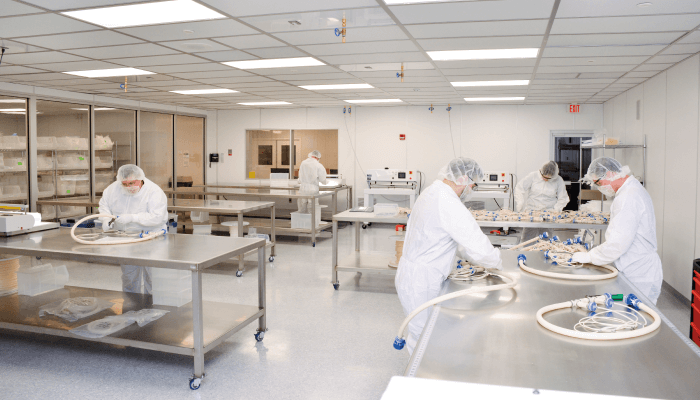Timothy Korwan: During the late 90s, I started working for a biotech company that relied heavily on stainless steel, but we slowly began introducing single-use technologies where we could see immediate benefits; first in filtration to replace multi-use components in the transfer steps between tanks. We realized immediate benefits by removing cleaning steps and saw a faster turnaround for some applications. Over time, we began integrating single use for simple 2D and 3D bags, holding containers and for non-sterile application buffers.
Sean DeFusco: We’ve always been using single-use products in the industry; we just used to call them disposable products. For example, though they fit into a reusable metal housing, the filters themselves would be thrown out after one use. Items such as tubing tended to be single use as well. It was when we started combining these components into more sophisticated systems that single use took on the meaning it has today. There was early demand to integrate ready-to-use systems in stainless steel environments, but they required a device to mate with the stainless steel. That’s when we saw the crossover begin, where single-use technology was introduced to a stainless steel system. As soon as those connectors were developed, uptake increased and the true benefits of single use began to be realized, making processes more efficient and cost-effective.

DeFusco: One defining moment was the introduction of aseptic disposable sampling systems in the early 2000s, which fundamentally changed the way sampling from stainless steel bioreactors was performed. Previously, taking a sample required steaming of all the metal parts and glass bottles, and it would often produce a bad result. False positives were common and by the time you figured this out it could be too late. With the introduction of closed, single-use sampling systems, no one sampled the old way anymore. New metal bioreactor designs also helped eliminate steam drops, and plants were even built without the capability to operate in the old way. We don’t have false positives anymore; we know the results are accurate. I think this highlighted the potential of single use – and from there, pharma companies began imagining other ways that single use could improve processes.
Korwan: Another significant milestone was the advent of the traveling wave single-use bioreactor, which was something that could not be easily scaled in stainless steel. The bag could be rocked to achieve the right oxygen transmission in the bioreactor, and it produced very good cell expansion.
Both the wave bioreactor and disposable sampling system fundamentally changed how biomanufacturing was conducted and inspired people to do things differently – without stainless steel. Single use led to a revolution in how to build and run a bioreactor, how to sample, and how to scale up production. Far more than just popularizing the use-it-once concept, the early adopters of single use changed the biopharma workflow at its core. And once the first single-use commercial-scale bioreactors were born, there was a significant leap forward.
Korwan: Initially, there were some concerns about cost, validation complexity, and regulatory reliability – in particular concerning the possibility of extractables and leachables. The main question was whether single use would negatively impact drug quality. There were also some early reliability problems and questions concerning leakage, but the main issue was trust: can you trust your highly valuable drug product to a plastic bag? Early on, I think many saw single use as an interesting concept with applicability to process development, but did not envision a future for the technology in commercial manufacturing.
But today, single use is prevalent throughout the biopharma industry. And it’s now acknowledged that it can be scaled up quickly for commercial drug manufacturing. In the early days, it was restricted to unique applications in initial-stage product development areas, but now it’s seamless across the entire scale and workflow. An entirely single-use facility is now possible.
DeFusco: In biopharma, early adoption of new technology is often not immediately seen as an advantage over competitors; people tend to take the “wait-and-see” approach.
People are more comfortable with single use today, largely because of big pharma’s high-profile experience with the technology. Consider the Takeda facility in Lexington, Massachusetts, which was one of the first commercial-scale plants with no cleaning systems. It was single use from beginning to end, and perfect for producing orphan drugs. Shire took the leap – under the close scrutiny of their competitors! The success of the company became a benchmark for others. The plant hosted many other drugs afterward, proving that single use was no longer theoretical, but a viable way of manufacturing medicines.

Korwan: Cleaning is one. Often, a stainless steel system must be disassembled when it comes to cleaning – and it’s a tedious and time-consuming job. Cleaning obviously isn’t required for single use so production is more continuous, meaning that a single-use plant can produce more batches per year than a traditional stainless steel facility. The lack of cleaning also comes with environmental benefits in terms of reduced water and energy consumption. On the flip side, however, stainless steel advocates point to the disposal problems with single-use systems, particularly unrecyclable plastics. The struggle to improve the recyclability of single-use systems used in biopharma manufacturing is an ongoing challenge.
Today, single-use products are used for the manufacture of the vast majority of drugs, particularly new drugs. The technology may not always extend to the bioreactor, but it is evident in sampling, fluid transfer and storage. The many fluid and material transfer interconnections between the different steps in drug production are rarely top of mind, but that’s where facilities are looking to single use to solve production challenges.
DeFusco: The lack of a cleaning requirement is a nice aspect of single use – certain features of a stainless system can be notoriously hard to clean! The reduced need for cleaning results in cost savings, but the broader economic picture of single use comes into play the most when building new facilities. A stainless steel facility can take years to build so the investment will be tied up for a very long time. Construction must begin early, but by the time the factory commences manufacturing it may already be out of date. Imagine buying a brand new car and then leaving it in a garage for eight years. It would still be new of course, but it would be very dated.
There is also the fact that many phase III drugs fail. There have been instances of facilities being built for a specific product, and then sold off or demolished before they are ever used – a huge waste of money. Single use plants are faster to get up and running, and the important build/not build decision can be delayed until there is more certainty about the future of the drug. If things do change after the facility has been built, it’s fairly straightforward to change out the single-use systems (replumbing an entire stainless steel facility on the other hand would be far more difficult). In short, single use offers much greater flexibility.
DeFusco: Facilities traditionally relied on a large engineering staff – internal or external - to design every detail of a facility, right down to the piping layout. Single use came along, and suddenly just a few people could do the job by sketching it on a notepad. There was a major loss of design rigor that caused considerable issues early on. Most companies today produce specifications with more detail than a mere sketch. Providing the necessary level of design rigor was a valuable lesson learned.
Another lesson we’re still learning ─ and COVID-19 is a great reminder ─ relates to the logistics and supply chain attached to single use; either all or part of the manufacturing plant must be shipped in to make every batch of drug. This huge logistical undertaking involves a complicated supply chain that is vulnerable to interruption events, such as weather, a disaster, or pandemic. In such cases, whole countries might not be able to export or import goods. Most drug plants were not built with an attached warehouse for all the consumables that single-use processes require, but the need to obtain, inspect, sort and store these items is critical to an effective supply chain.
Korwan: The topic of supply chain logistics often goes unnoticed because we talk about the technology so much. But whether it’s film chemistry or tubing or connectors or sensors, if you don’t have it all packaged for delivery when you need it ─ and able to withstand typical and atypical transit trouble ─ it doesn't matter how good the technology is: it won’t get there. This aspect is not considered enough in the single-use world. Vendors have to put a lot of work into establishing their supply chains and logistics processes. And if you’re looking to adopt single use you need to take this into consideration early in your planning.

Korwan: When designing or writing a specification for a single-use application, my advice is to design for the application – you should always try to be as agnostic as possible when it comes to components in your design. I’ve seen too many designs specify components by specific vendor and this limits the flexibility of that design. Of course, there will always be exceptions, but thinking first about the application and function is best practice and allows you to design for easy substitutability and second-sourcing where prudent. For instance, don’t write a specification using vendor names, but select materials based on application Including a particular vendor requirement in your specification can limit your capabilities if there’s a problem with that vendor or the production process. Think more about the technology and what you’re trying to achieve – and don’t write specifications in a counter-productive way.
DeFusco: I’ve seen some mistakes when companies decide that adopting single use is their primary goal. The primary goal should always be to make every batch of drug product reliably and predictably. Single use can help achieve that goal, but some projects focus too intently on implementing single use. If you keep the real goal in mind, a single-use approach can work well and reduce costs. But ultimately it depends on what fits your business plan. Some companies may prefer to stick with stainless steel. The facility location and the intended scale of production will likely lead you in one direction or another. For example, in drier regions where water is less available, cleaning less frequently is a much bigger factor in decision making.
DeFusco: There is plenty of room for improvement in materials and deliverability. In some emerging areas, such as cell and gene therapy, the industry is adapting products that came from the medical device industry. There are shortcomings there, but they are the only materials/approaches currently available. It’s similar to where we were 15+ years ago in biotech when we were using available industrial products and adapting them to the needs of the biopharma industry. But innovation led to big improvements – and the same will happen with emerging fields.
Korwan: Beyond improving the supply chain for single use, there are huge areas for improvement in the general capacity of the industry. Materials and construction continue to get better and more specific, especially at the molecular level.
DeFusco: Most people are only interested in a standard product if it is their standard. We’re a long way from having a true consensus standard, which would require that every drug plant be built the same. We can certainly make a standard assembly, but if the spacing between equipment isn’t uniform in every factory in the world, it just won’t work. Worse, too much standardization can stifle innovation. The opposite is also bad, where every new application needs a new set of drawings, assemblies, bags, and so on.
Modularity is the likely path forward. It may not lead to standardization across the industry, but it drives the process within each plant. A single facility may use many duplicates and redundant skews. There is an enormous opportunity to reap some benefits of standardization by reducing skews and simplifying supply chains, but still allowing each drug manufacturer to develop incremental process improvements.
Korwan: Standardization can also apply to the manner in which things are done, such as how to conduct audits, and how we request data and provide information. This topic has become prominent during the pandemic. For example, consider a situation where we are helping with a new COVID-19 therapeutic. The client requires an audit, but the auditors are quarantined and can’t travel to the site. A standardized audit procedure would enable others to step in and do the job. I think there are no doubt many opportunities to standardize in areas like this, which would lead to increased efficiencies.
DeFusco: When purchasing stainless steel equipment, you are looking for a vendor that can deliver the product you need on time and in spec. Though some after installation support might be necessary, it is mostly a discrete project. When you choose a single-use process, you’re choosing a partner – likely for the lifetime of that drug product, so choose carefully! It's a very different decision and involves different criteria, such as supply chain considerations.
Korwan: It’s a fundamental difference in approach and a complete shift in mindset. You want a company that can manage a project really well and deliver worthwhile results. Trust and reliability are everything. You need people who can run a project properly and deliver consistently for as long as you make that product.
GPEx® Lightning is a fast, flexible way to shorten the path to production of phase 1 material. During this talk, we share the latest data leveraging GPEx® Lightning to generate highly stable, highly productive cell pools.





